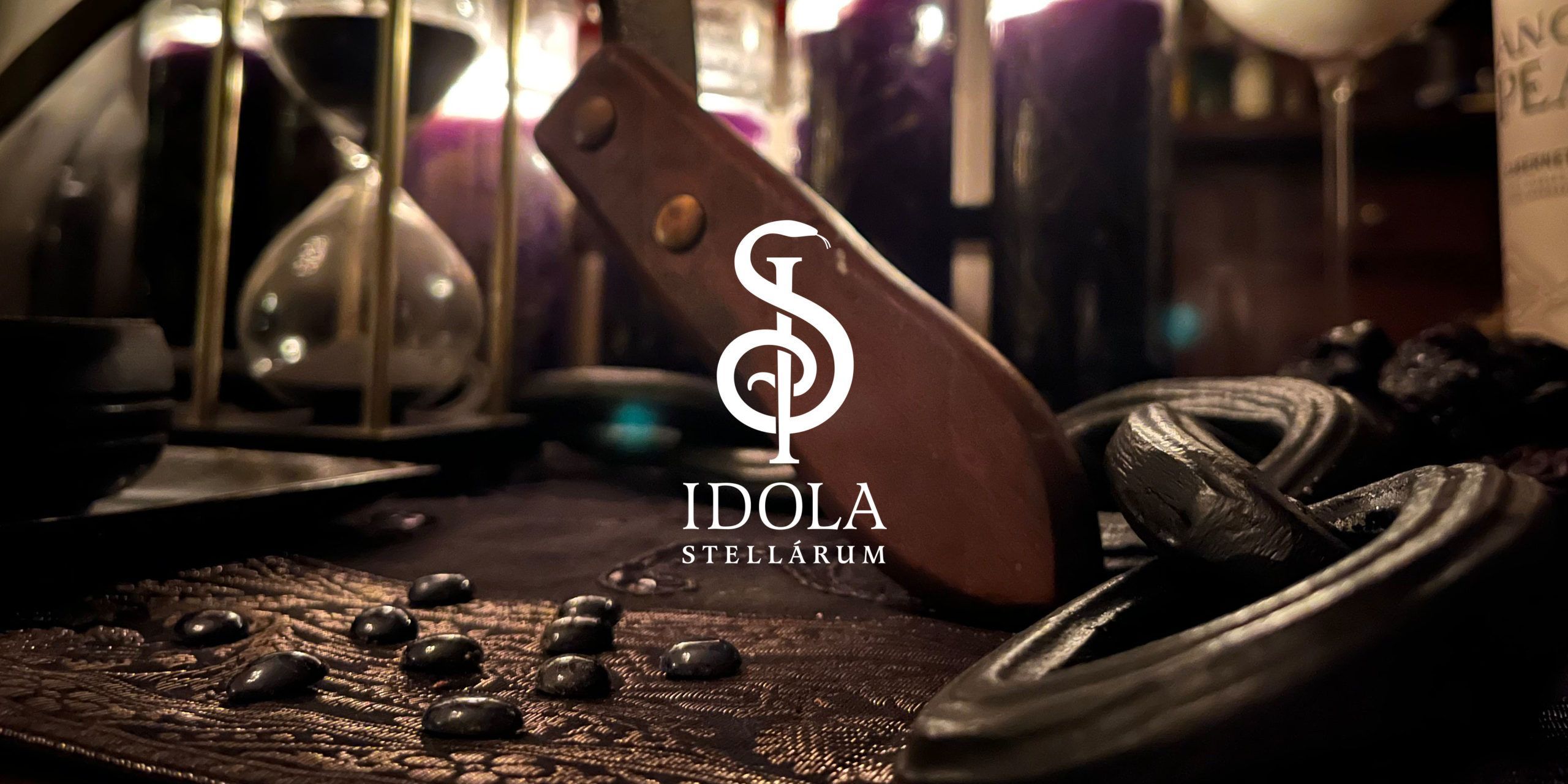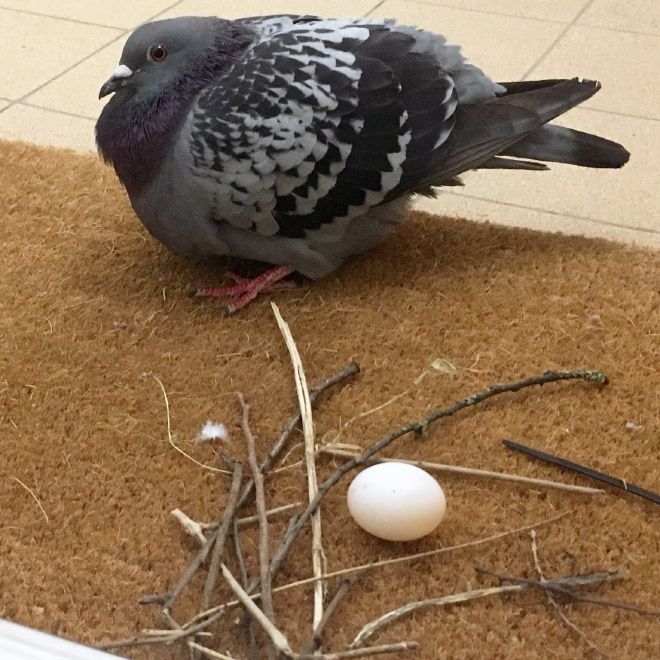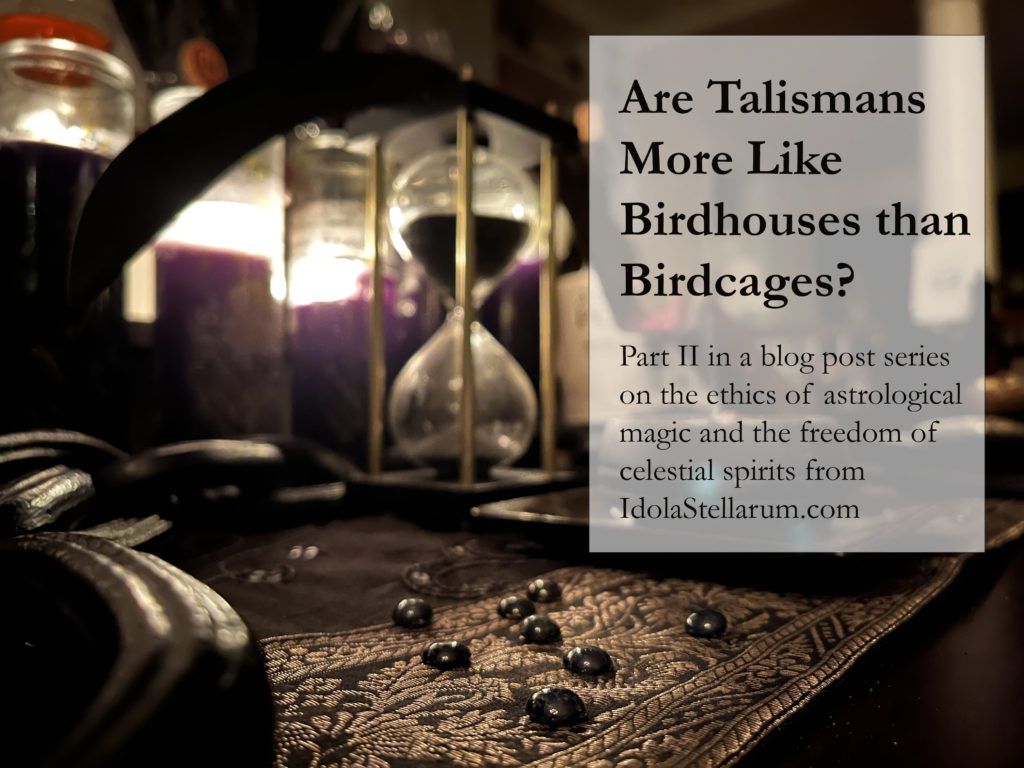Your cart is currently empty!

Talismanic Gemstones are more like Birdhouses than Birdcages: On the Essential Freedom of Celestial Spirits (Part II)
In Part I of this post series on the freedom of celestial spirits, we examined source texts in the tradition of astrological magic and compared the methods of astrological magic to the methods of Solomonic magic to reject the idea that talismans are like birdcages. That is, celestial spirits do not become trapped or imprisoned within talismans, but rather get invited to willingly reside there. In this second part of this post series, we further develop these considerations and offer another way of thinking about astrological talismans.
In this post, we will explore the idea that making a talisman is better understood not as trapping a spirit in something like a birdcage, but more like building something like a birdhouse for a spirit with free agency. In this view, when making astrological talismans, the mage can be understood as preparing a suitable home for a spirit of the celestial hierarchy who willingly abides there and can freely come and go as they please.
Talismans are more like Birdhouses than Birdcages
As we wrote about before, astrological magicians use methods of supplication, prayer, and petition to elicit the cooperation of willing spirits to freely reside within the gemstone (or metal) that forms the material base of the talisman.
Having rejected the metaphor of the talisman as birdcage, we can now suggest a better metaphor riffing off of the basic idea. Perhaps we could consider a talisman as a kind of a birdhouse: a fitting material location that we set out for a spirit where it might comfortably join us at the fringes of our ecosystem, while understanding that the spirit will be entirely free to be itself and participate in its own natural activities.
So, what is a birdhouse? From a certain perspective, almost anything could be a birdhouse. One could, of course, go to the local gardening store and buy a beautiful birdhouse, or spend a weekend or longer at the hardware store and workshop and build the perfect birdhouse. A bird could also live in a cardboard box, within the rim of a car tire, inside the hollow of a watering can, or any number of place. When we stop to think about natural bird nests, some birds dig into the ground, some burrow into trees, some build platform nests, and others build cup nests. Pigeons infamously need only a few sticks or twigs to prevent eggs from rolling away.

From a very abstract perspective, any materials could be used for a birdhouse. Similarly, in astrological magic, we find that mages make talismans out of not just gemstones and metal, but also wax and paper. Some traditional sources suggest that almost any material could be used to make a talisman. Agrippa, for example, could be read in multiple places as giving broad license to experiment:
“Therefore, you must recognize which and what kinds of materials, either by nature or art, begun or completed, or collected from many [things], which celestial influences they are able to receive. Indeed, the agreement of natural things is sufficient for drawing from celestial influences: because nothing hinders the celestials from pouring down their light toward the inferiors, and they permit no matter from being void of their virtues.”
—Agrippa, Three Books of Occult Philosophy, Book I, Ch. 36, emphasis added
Arguably, this quotation states that although some materials are more suitable than others, no material would be so base as to prevent its use as a talisman. Similarly, Agrippa later writes:
“Indeed, the celestial bodies are animated, alive, sensual, and grant wonderful and most vehement powers, even in a sudden moment, and suddenly touch images to imprint wonderful virtues—even in less suitable materials.”
—Agrippa, Three Books of Occult Philosophy, Book II, Ch. 35, emphasis added
One could certainly read these quotations as giving permission to use “less suitable materials.” And indeed, going back to our birdhouse metaphor, you could make one out of anything. You could make a birdhouse out of cardboard or bits of scrap metal, for instance. If you did, however, birds might show some interest but ultimately leave when the birdhouse gets ruined by the weather, or when the bird finds a more comfortable and appealing home.
Building a Better “Birdhouse”: Why the Type and Quality of Material Matters for Talismans
When we stop to think about it, we cannot deny that birdhouses can be poorly made or well-constructed: they can be fitting or unfitting for a particular type of bird. A better birdhouse would take into consideration what type of bird we are trying to attract, their natural preference for nesting materials, and their needs in terms of space and food. Going back to Agrippa, he agrees that the type and quality of materials does matter. The above quotation from Book II of Three Books of Occult Philosophy continues:
“Yet they grant more effective virtues in images if they are not fabricated from anything but certain materials–that is, whose natural and specific virtues likewise agree with the operation and the figure of the image is similar to the celestial figure.
In fact, such an image, because of the operation of the natural material and agreement with celestial influences, and because of the similarity of the figure with the celestial figure, is most prepared for the actions and powers of the celestial bodies.”
—Agrippa, Three Books of Occult Philosophy, Book II, Ch. 35
Marsilio Ficino, as well, notes that certain materials rather than others better receives the rays of certain celestial entities. He further notes that if you intend to create an astrological talisman out of gemstone or metal, these hard, unyielding materials are hard to combine with one another. Although you can alloy metals together, certain metals more easily combine with certain others. And gemstones cannot be combined with one another at all, unless you were to grind them up and re-fashion them into a conglomerate, effectively destroying and dispersing their virtues in the process. For these reasons, we have to be selective. Ficino writes:
“But since you cannot easily compound several things of this kind [i.e., metals and gems], you are forced to inquire diligently what metal among others is most powerful in the order of any given star, what stone is highest in that order, so that at least in some one thing, supreme in its entire genus and order, you may, insofar as possible, comprehend the rest, and that you may borrow in a receptacle of this kind celestial things that are in sympathy with it.”
—Marsilio Ficino, Three Books on Life, Ch. XIII
It is easy to see that quality matters for Ficino. And this makes sense from the perspective of the astrological mage. If a given astrological configuration is relatively rare, and the temporal window for making talismans is very brief, wouldn’t you want to make most effective use of the incredibly limited temporal resources you have?
Ficino frames the choice of materials in terms of which is the most “powerful.” Within the framework of natural magic, this makes sense: certain materials have more or less of a given natural virtue. Within a spirit model, however, we might frame it differently.
Thinking back to birdhouses, some birds would be more comfortable in certain environments rather than others. Applying these considerations to making astrological talismans, some spirits feel more at home in some materials rather than others. And although we do not dismiss the idea of “power,” we prefer to think about relationship.
Working within a spirit model, we would act accordingly as if a bird comes and goes as they please to a birdhouse: we would build a house within their specific habitat, with materials that protect them from their specific threats, surrounded by and even providing for them the consistent food they need to thrive.
Becoming a human steward of a birdhouse is not so different than becoming a human steward of a talisman, after all. Building it a beautiful home, keeping it safe and secure, and making offerings can all be part of the relational work of the astrological magician.
Thinking along these lines, astrological magicians would be well advised to consider what types of gemstones and metals, herbs, and suffumigations would best attract the type of spirit we are inviting and render them comfortable and ultimately resourced.
The source texts within the tradition of astrological magic abound with evidence supporting the idea that materials matter. Book II, Chapter 10 of the Picatrix is one the premiere recipe lists for astrological talismans, and it begins with the author saying that they “intend to reveal how each planet corresponds to metals and stones, and to the figures of the planets and their marvelous operations.”
This introductory passage to Book II, Chapter 10 of the Picatrix is remarkable in how it showcases materials first, and images only second (although we must note that in other places, the centrality of images gets foregrounded). Following a list of gemstones and metals, the chapter lists images alone before then providing specific talismanic recipes that combine an image with a gemstone and/or metal with a specific intention or effect. The link between specific materials, specific celestial entities, and specific purposes or intentions is impossible to miss, and impossible to deny.
Starting from the assumption that celestial spirits have agency and affinity, can either cooperate with us or not, and are not obliged to remain in our presence, wouldn’t we want to treat them with as much respect as possible and build them the best “birdhouses” we can within our means? We certainly think so.
In Part III of this series, we will take a deeper dive into the spirit model and offer a more integrated perspective that transcends ideas of cages and houses.
In case you missed it, check out In Part I of this post series on the freedom of celestial spirits, in which we ask and answer the question: are astrological talismans more like birdcages or birdhouses?
We also recommend delving into Amaya Rourke’s practical guide to crafting high quality celestial talismans on a budget, which dovetails with the concerns about materials we spelled out above.
As stewards of the tradition of astrological magic, it is our privilege to bring the wonder of astrological talismans to others. Sign up to our mailing list for word of our upcoming talismanic collections and workings:
By clicking ‘subscribe’, I consent to Idola Stellarum storing my email and information solely for the purpose of communicating upcoming offerings and content, and I am able to unsubscribe at anytime.

